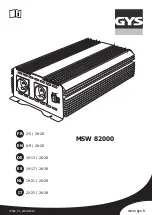
CONNECTION
Follow these steps to ensure proper use of the product.
A bad connection can destroy the inverter.
Before connecting the inverter to the battery, make sure that the switch is set to OFF.
1.
The inverter is supplied with two red and two black cables.
Connect the red cables to the positive input terminals of the inverter and the positive terminal of the battery.
Connect the black cables to the negative input terminals of the inverter and the negative terminal of the battery.
Don’t reverse polarities, it may damage the inverter.
Make sure that the cables are firmly connected.
2.
Before starting the inverter and connecting electrical equipment, please observe the following instructions:
-
Before charging, carefully check whether the charging current of the device is lower than the inverter cur
-
rent. If it is higher than the converter charging current, do not make the connection that may damage the
USB port.
-
For safety reasons, it is not recommended to exceed a consumption of 2000 W per AC output socket (7). Try
to share the global consumption on all sockets.
- Certains appareils doivent être rechargés avec leur chargeur d’origine, ne pas le faire avec le port USB.
- For best operation, it is recommended to use a battery exceeding 200 Ah.
3. Set the switch to the ON position. The green indicator comes on.
4.
Insert the electrical device plug into the AC (7) output socket of the inverter.
APPLICATIONS
1.
Applications
a. Use only for class II devices.
b. Fields of application of the electrical device that are not applicable :
• All electrical appliances that exceed the inverter’s power rating.
•
Generally, capacitive charging devices are not applicable: air conditioning, electric drill, refrigerator, microwave,
blender.
We do not recommend using this inverter with devices that have strict power supply requirements,
such as precision equipment. Using the inverter with this kind of device may affect the measure
-
ment data..
c. Scope of the electrical device that is not applicable with USB :
• USB does not have a data exchange function.
2.
Check carefully the voltage before usage:
• the input voltage of the inverter must be the same as the battery;
• the operating voltage of the device must be the same as the output voltage of the inverter;
• once all identical, connect them correctly by following the «connection explanations» in this manual.
3.
Use the inverter in a ventilated condition to make sure that the fan is not blocked. Do not place the inverter under
rain or in a humid place, keep it dry to maintain a long lifespan. Use the inverter below 85% of the corresponding power.
4.
The inverter includes an input overvoltage protection function, an overload protection function, an overtemperature
protection function and a short-circuit protection function. In each cases the inverter stops working. To make it work
again, turn it off, correct the defect, then turn it on again.
5.
To increase the efficiency, the fan will not work unless the following two situations:
a. When the load is higher than 30% of the inverter power.
b. When the inverter temperature exceeds 60°C.
6.
Using an extension cable:
a. It is not recommended to use an extension cable between the inverter and the battery, as this would cause DC
electricity loss and affect the inverter’s performance.
b. If you need to use an extension cable, use a high quality one to reduce power loss.
8
MSW 82000
EN
Translation of the original instructions









































